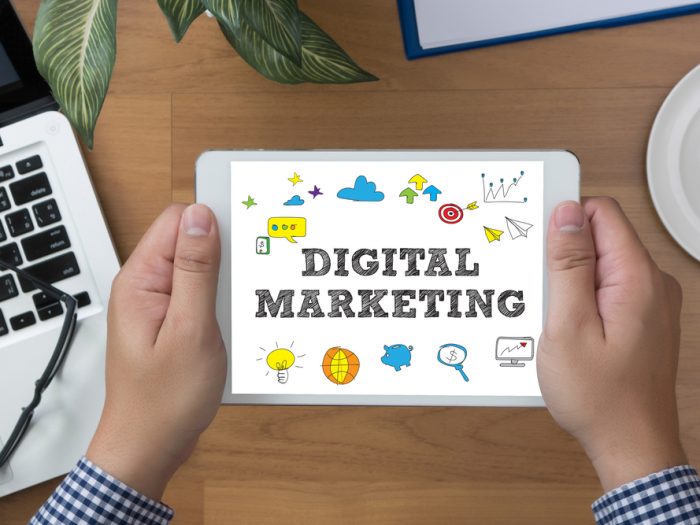Ever wonder how some organisations are managing to get ahead in these challenging times?
As a result of the pandemic, firms’ digital communications plans have been expedited by an average of 6 years, as businesses explore new ways to engage with customers in a digital-first society.
Customers have learned to demand digital experiences that are tailored to their specific requirements.
In the B2B space, buyers are bombarded with irrelevant content. Highly tailored, B2C-like experiences can generate significantly higher levels of engagement.
Marketers can achieve this through content personalisation, using a combination of historic data and predictive analytics to engage more meaningfully with audiences wherever they are on the digital journey. Google has found that customers are 40% more likely to spend more than planned when their user experiences are highly personalised. They’re also actively encouraging organisations to invest in optimising their customer touchpoints by changing the search algorithm by May 2021 to reward websites that provide a greater on-page experience with higher organic rankings.
Simultaneously, over the last few years, there has been an explosion in marketing data. When you have a rising number of sources across an increasingly complicated ecosystem of systems and tools, extracting useful insights from your data can be difficult.
With so much data available, only 49% of marketers say they have a completely unified view of potential sources, which makes it challenging to take action.
So, what kind of data is most beneficial for providing the individualised digital experiences that customers expect? Wherever your audience is on their digital journey, how can you reach them with continuous and compelling content marketing? And how do you allocate your limited marketing resources to achieve these objectives? Continue reading to find out.
Using data to inform digital marketing
Building a long-term relationship with customers and establishing the loyalty required to collect the data needed to personalise content necessitates a long-term strategy. The more accurate and relevant data you collect, the more customised your outreach may be.
Simply collecting information from various sources isn’t enough: where the magic happens is when you unify, analyse and generate actionable insights from that data. The most effective marketing strategies are based on continuous experimentation to find the right combination of relevant data points that enable organisations to create content that resonates with target audiences.
Internal data sources should include:
-
Web analytics
-
Social media analytics
-
CRM systems
-
Product or platform user analytics
-
eCommerce history and shopping patterns
-
App engagement
-
Email engagement
-
Customer surveys
-
Advertising and other paid marketing activities
There are many ways to enrich that data by combining it with external sources. This type of information helps you gain a deeper understanding of specific markets, trends, consumers, demographics, geographies and industry sectors that matter for your business.
Examples of external data sources include:
-
Business statistics
-
Market research
-
Industry reports
-
Publicly available data from government agencies and non-profit organisations
-
Insights from your business partners
Applying marketing data to achieve your goals
Once you’ve listed out all your potential data sources, it can seem rather overwhelming to prioritise which ones to focus on.
A first step should be to map out what’s most critical to reach your specific marketing goals. Other considerations include time to market, budget and potential opportunity impact.
Prior to any commercial engagement or purchase, clients will have several contacts with your brand, making it equally critical to understand how to draw the connections between your numerous data sources to draw insights as they progress through their journeys.
Your organization’s and business goals will dictate how you use your data. Here are a few different combinations of sources you can try to obtain certain results:
It is therefore critical to use your data to engage your customers with the right message at the right time on the right channel. That’s where content personalisation can step in to help you stand out amongst the noise.
Increasing customer engagement through content personalisation
The average person receives 121 emails a day and interacts with thousands of ads. Incorporating content personalisation throughout your digital touchpoints can increase engagement at every stage and improve loyalty. Customers who feel that your brand genuinely meets their needs are more likely to both make the initial purchase and continue to come back for more.
Recent research has found that:
- Customers are 2.1x more likely to view personalised offers
- 80% of companies report seeing an uplift since implementing personalisation
- Personalisation can increase marketing spend efficiency by up to 30%
Dynamic content personalisation enables marketers to automatically change the content your users see based on how you have segmented your audiences and other database-driven signals.
Customer data points that should be used for audience segmentation will include:
-
Gender
-
Age
-
Location (city, country, region)
-
Device (smartphone, tablet, iOS, Android, Windows, Mac, etc.)
-
Visitor frequency
-
Date and time of day
-
Referring URL
-
Campaign activity (through UTM codes)
-
Email and landing page engagement
-
Paid advertising engagement (Google Ads/Shopping, Facebook Ads and Instagram Ads , etc.)
-
Purchase history
Generating marketing ROI by reaching customers with relevant content
A company that does personalisation very well is Amazon: every one of their customers has a personalised homepage based on their browser history and purchase history, creating a curated shopping experience. 35% of what consumers purchase on Amazon now comes directly from these personalised recommendations. Also, even if there’s no pre-existing customer profile, website visitors around the world are automatically served content in their native language and currency according to their location.
Many other companies are experimenting with how to increase engagement through content personalisation. Zumba Fitness used a personalised video to grab the attention of instructors for their annual convention and saw the click-through rates increase from 5.4% in the control message to 21% in the personalised message – at 50% it was the highest click-to-open rate they had ever achieved.
Less conventional data points can sometimes be the most effective when it comes to creating individual messages that resonate with your customers. Pet retailer Doggyloot gathers data based on their customers’ dogs’ name, breed, size, gender and birthday. Personalising emails based on the size of dog led to click-through rates 410% higher than the company average and dog birthday related promotions contribute up to 16% of their daily total revenue.
People, markets and the world we live in are constantly evolving. Experimenting with personalisation enables you to precisely determine which messages resonate with your audience segments. New emerging technology enables you to optimise content across the customer journey, powered by machine learning with automation that delivers a human approach at scale.
Centralising digital experiences to optimise the customer journey
Digital Experience Platforms (DXPs) provide a solution to the fragmented data landscape many marketing and IT teams struggle to integrate in order to effectively deliver personalised content for their customers. Gartner defines a DXP as “an integrated set of core technologies that support the composition, management, delivery and optimization of contextualised digital experiences.”
DXPs are a development of the traditional CMS approach to organising content, data, and other media for your digital window to the world. They make it possible for you to:
-
Personalise content and user experiences across every digital touchpoint
-
Track and analyse user behaviour to inform data-driven decision making
-
Conduct experiments to continuously improve engagement rates
-
Create and manage omnichannel content, removing the burden of manually creating and distributing content multiple times for different customer touchpoints
-
Limit IT complexities with a single “central nervous system” for all internal and external user experiences
-
Automate workflows between teams, systems and across the organisation, reducing time spent gathering data so you can focus on deriving insights and driving results…and much more!
In 2019, RedBull Media House consolidated all their web properties, omnichannel and global content onto one platform. As a media company, their main goal was to increase web visitor engagement and content consumption on their channels. By getting their entire marketing and content production team collaborating on the same data through the same interface, they dramatically improved their operational efficiency to produce more targeted content at scale. These newly streamlined processes delivered a consistently engaging, personalised experience for their users across every digital touchpoint.
The results? An uplift of +66% average time on page, +150% page views and +230% video views.
What next?
How do you effectively leverage your limited resources for maximum impact once you’ve identified all the numerous ways you may use data and content personalization as part of your marketing strategy? You’re not alone in finding it difficult to acquire a holistic view of digital marketing performance: Only 5% of CMOs claim they can confidently evaluate the impact of data-driven engagement on the bottom line.
Would you like a free digital analysis to assist you in becoming a true data-driven marketer? The Altis Impact Analysis gives marketers a comprehensive assessment of their current digital marketing strategy, as well as best practises for performance, automation, A/B testing, analytics, audience segmentation, and personalization.
Get in touch with the Finsbury Media team – to find out how our Impact Analysis could help you achieve your digital marketing goals.




